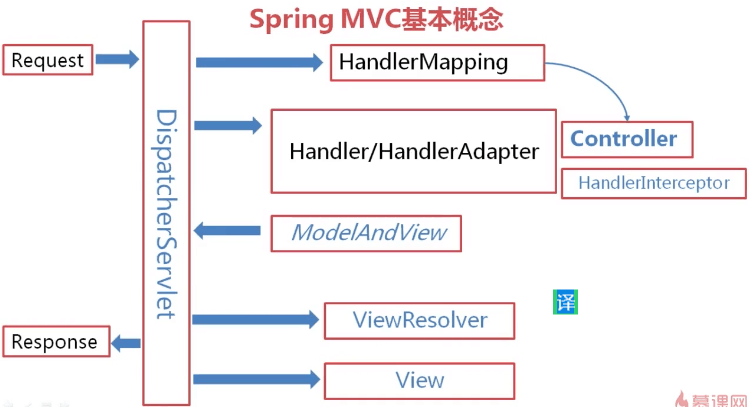mvc
mvc是web程序开发一种通用的架构。mvc的核心思想:业务数据的抽取和业务数据呈现相分离。
spring MVC基本概念

理解过程:浏览器的request过来,DispatcherServlet拦截request,DispatcherServlet通过HandlerMapping去寻找controller,将功能代理给HandlerMapping。 HandlerMapping找到了controller和HandlerInterceptor,形成一个执行链条,作为一个HandlerAdapyer。 写controller就是为了生成相应的model,返回给DispatcherServlet,然后通过视图解析器, 返回view对象,将模型数据传给view,就呈现我们的页面。
基于maven的spring MVC 例子
- 打开myeclipse,新建一个maven的工程,如何在myeclipse中建立一个maven工程,详细的请看maven中讲解。
- 配置整个工程需要的依赖坐标,具体的配置信息如下:
<project xmlns="http://maven.apache.org/POM/4.0.0" xmlns:xsi="http://www.w3.org/2001/XMLSchema-instance"
xsi:schemaLocation="http://maven.apache.org/POM/4.0.0 http://maven.apache.org/maven-v4_0_0.xsd">
<modelVersion>4.0.0</modelVersion>
<groupId>com.example.test.springmvc</groupId>
<artifactId>springmvc</artifactId>
<!-- <packaging>war</packaging> -->
<version>0.0.1-SNAPSHOT</version>
<name>springmvc Maven Webapp</name>
<url>http://maven.apache.org</url>
<properties>
<spring.version>4.3.10.RELEASE</spring.version>
</properties>
<dependencies>
<dependency>
<groupId>org.springframework</groupId>
<artifactId>spring-framework-bom</artifactId>
<version>4.3.10.RELEASE</version>
<type>pom</type>
</dependency>
<dependency>
<groupId>org.springframework</groupId>
<artifactId>spring-webmvc</artifactId>
<version>4.3.10.RELEASE</version>
</dependency>
<dependency>
<groupId>junit</groupId>
<artifactId>junit</artifactId>
<version>3.8.1</version>
<scope>test</scope>
</dependency>
<dependency>
<groupId>javax.servlet</groupId>
<artifactId>javax.servlet-api</artifactId>
<version>3.0.1</version>
<scope>provided</scope>
</dependency>
<dependency>
<groupId>commons-lang</groupId>
<artifactId>commons-lang</artifactId>
<version>2.6</version>
</dependency>
<dependency>
<groupId>org.slf4j</groupId><!--基于日志管理的包 -->
<artifactId>slf4j-log4j12</artifactId>
<version>1.7.25</version>
<scope>test</scope>
</dependency>
</dependencies>
<build>
<finalName>springmvc</finalName>
<plugins>
<plugin>
<groupId>org.mortbay.jetty</groupId>
<artifactId>maven-jetty-plugin</artifactId>
<version>6.1.25</version>
</plugin>
</plugins>
</build>
</project>
- 在web.xml下配置DispatherServlet(前端控制器)
<!DOCTYPE web-app PUBLIC "-//Sun Microsystems, Inc.//DTD Web Application 2.3//EN" "http://java.sun.com/dtd/web-app_2_3.dtd" > <web-app> <display-name>Archetype Created Web Application</display-name> <servlet> <servlet-name>springmvc-dispatcher</servlet-name><!-- DispatcherServlet对应的上下文配置,默认是/WEB-INF/$servlet-name$-servlet.xml --> <servlet-class>org.springframework.web.servlet.DispatcherServlet</servlet-class> <init-param> <param-name>contextconfiglocation</param-name> <param-value>WEB-INF/config/springmvc-dispatcher-servlet.xml</param-value></init-param><load-on-startup>1</load-on-startup></servlet><servlet-mapping><servlet-name>springmvc-dispatcher</servlet-name><url-pattern>/</url-pattern><!-- 这里改变默认的位置,所以要在对应的位置创建该文件--></servlet-mapping></web-app><!--这里过滤所有的请求-->
- 创建上述的文件,并进行配置。
<?xml version="1.0" encoding="UTF-8"?>
<beans xmlns="http://www.springframework.org/schema/beans"
xmlns:xsi="http://www.w3.org/2001/XMLSchema-instance"
xmlns:context="http://www.springframework.org/schema/context"
xmlns:mvc="http://www.springframework.org/schema/mvc"
xsi:schemaLocation="http://www.springframework.org/schema/mvc http://www.springframework.org/schema/mvc/spring-mvc-4.3.xsd
http://www.springframework.org/schema/beans http://www.springframework.org/schema/beans/spring-beans.xsd
http://www.springframework.org/schema/context http://www.springframework.org/schema/context/spring-context-4.3.xsd">
<context:annotation-config/>激活注解
<!-- 配置包扫描,扫描controller -->
<context:component-scan base-package="com.example.springmvc">
<context:include-filter type="annotation" expression="org.springframework.stereotype.Controller"/><!-- 只用于管理@controller的bean,忽略@service等其他的bean。 -->
</context:component-scan>
<!-- HandlerMapping, 无需配置, Spring MVC可以默认启动。 DefaultAnnotationHandlerMapping
annotation-driven HandlerMapping -->
<!-- 注解驱动,配置映射器和适配器 --><!-- 扩充了注解驱动,可以将请求参数绑定到控制器参数 -->
<mvc:annotation-driven></mvc:annotation-driven>
<!-- 视图页面配置 -->
<!-- 配置ViewResolver。 可以用多个ViewResolver。 使用order属性排序。 InternalResourceViewResolver放在最后。 -->
<bean class="org.springframework.web.servlet.view.InternalResourceViewResolver">
<property name="prefix" value="/WEB-INF/jsp/" />
<property name="suffix" value=".jsp" />
</bean>
</beans>- 创建controller类
package com.example.springmvc;
import org.springframework.stereotype.Controller;
import org.springframework.web.bind.annotation.RequestMapping;
@Controller
@RequestMapping("/hello")
public class HelloSpringMvc {
@RequestMapping("/mvc")
public String helloMvc(){
return "home";//返回的是home.jsp
}
}
由此可见访问地址:http://localhost:8080/项目名/hello/mvc
spring上下文配置
细心的小伙伴,在上述中,可以看到没有进行spring配置。
<?xml version="1.0" encoding="UTF-8"?>
<web-app version="2.4" xmlns="http://java.sun.com/xml/ns/j2ee"
xmlns:xsi="http://www.w3.org/2001/XMLSchema-instance"
xsi:schemaLocation="http://java.sun.com/xml/ns/j2ee
http://java.sun.com/xml/ns/j2ee/web-app_2_4.xsd"></web-app>- 在上述的web.xml中添加spring上下文
<!-- 配置spring上下文 -->
<context-param>
<param-name>contextlocation</param-name>
<param-value>/WEB-INF/applicationContext.xml</param-value><!-- 指明spring上下文位置 -->
</context-param>
<listener>
<listener-class>org.springframework.web.context.ContextLoaderListener</listener-class>
</listener>- 创建applicationContext.xml文件
<?xml version="1.0" encoding="UTF-8"?>
<beans xmlns="http://www.springframework.org/schema/beans"
xmlns:xsi="http://www.w3.org/2001/XMLSchema-instance" xmlns:context="http://www.springframework.org/schema/context"
xmlns:mvc="http://www.springframework.org/schema/mvc"
xsi:schemaLocation="
http://www.springframework.org/schema/beans
http://www.springframework.org/schema/beans/spring-beans.xsd
http://www.springframework.org/schema/context
http://www.springframework.org/schema/context/spring-context.xsd
http://www.springframework.org/schema/mvc
http://www.springframework.org/schema/mvc/spring-mvc.xsd">
<context:annotation-config /><!-- //激活注解 -->
<context:component-scan base-package="com.imooc.mvcdemo">
<context:exclude-filter type="annotation"
expression="org.springframework.stereotype.Controller" /><!-- 在这个spring容器中就不需要管理controller -->
</context:component-scan>
</beans>spring MVC中controller的变量绑定
package com.example.springmvc; import javax.servlet.http.HttpServletRequest; import org.springframework.stereotype.Controller; import org.springframework.web.bind.annotation.PathVariable; import org.springframework.web.bind.annotation.RequestMapping; import org.springframework.web.bind.annotation.RequestMethod; import org.springframework.web.bind.annotation.RequestParam; @Controller @RequestMapping("/hello") public class HelloSpringMvc { private String name; //处理请求类型:http://localhost:8080/项目名/hello/requestone/name= @RequestMapping(value="/requestone",method=RequestMethod.GET) public String requestMethod(@RequestParam("name")String name){ return "home"; } //处理请求类型:http://localhost:8080/项目名/hello/requestone/liu {name} {}是指变量name @RequestMapping(value="/requestone/{name}",method=RequestMethod.GET) public String requestMethodtwo(@PathVariable("name")String name){ return "home"; } //处理请求类型:http://localhost:8080/项目名/hello/requestthree/name=? @RequestMapping(value="/requestthree") public String requestMethodthree(HttpServletRequest request){ String name = request.getParameter("name"); System.out.println(name+"sdsadsada"); return "home"; }@RequestMapping(value="/create",method = RequestMethod.GET,params="add")//只有参数变量,没有值//处理请求类型:http://localhost:8080/项目名/hello/requestthree/add
public String createCourse(){
return "course/create";
}}Binding数据绑定
将请求中的字段按照名字匹配的原则填入模型对象。下面一个简单例子:controller类@RequestMapping(value="/create",method = RequestMethod.GET,params="add") public String createCourse(){ return "course/create"; } @RequestMapping(value="/save",method = RequestMethod.GET) public String saveCourse(Course c){ System.out.println(c.getName()); return "course/show";
数据实体类对象
package com.example.springmvc.model; public class Course { private String name; public String getName() { return name; } public void setName(String name) { this.name = name; } }
<form method="get" action="<%=request.getContextPath()%>/hello/save"> <input type="text" name="name"/> <button type="submit">提交</button> </form>注意表单元素的name属性一定要和数据实体类一致,否则不能完成数据的绑定
Spring mvc文件上传
提供文件上传工作,作为公共服务。只需要进行相应的配置就可以使用。
首先先在spring mvc 核心配置文件中(springmvc-dispatcher-servlet.xml),进行如下的配置:
文件解析的bean
<bean id="multipartResolver" class="org.springframework.web.multipart.commons.CommonsMultipartResolver">
<property name="maxUploadSize" value="209715200" /><!-- 设置文件上传的最大字节 -->
<property name="defaultEncoding" value="UTF-8" />
<property name="resolveLazily" value="true" /> <!-- 设置文件是否延迟加载,来捕获大小异常 -->
</bean>提供一个文件上传的表单
<form method="post" action="<%=request.getContextPath() %>/hello/end" enctype="multipart/form-data">
<input type="file" name="file"/>
<input type="submit">提交</input>
</form>controller
@RequestMapping(value="/startupload",method = RequestMethod.GET)
public String startupload(){
return "file";
}
@RequestMapping(value="/end",method = RequestMethod.POST)
public String endupload(@RequestParam("file")MultipartFile file){
System.out.println(file.getOriginalFilename());
return "course/show";
}
在这里利用requuestparam绑定绑定表单元素,通过MultipartFile获取文件的信息,进行文件相应的操作。




















 1万+
1万+











 被折叠的 条评论
为什么被折叠?
被折叠的 条评论
为什么被折叠?








